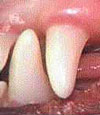How many teeth should a dog or cat have? Do they have baby teeth? When do they lose them? These are some commonly asked questions, so here are the facts to answer all your dental dilemmas.
Types of teeth
Open wide! The four types of teeth in small animals are as follows: incisor, canine, premolar, and molar. Nature designed each to serve a special function.
Incisors
Incisors are named first, second and third (or central, intermediate, and lateral) based on their location in the mouth. There should be six incisors in the maxilla (upper jaw) and six in the mandible (lower jaw). Incisor teeth are used for shearing and grooming.
Canines
Normally, the lower canine should intersect the upper lateral incisor and upper canine.
Two large canine teeth are located in the mandible and two in the maxilla. The canines are designed to grasp and tear with great pressure.
Premolars and molars
Premolar teeth have sharp edges used for shearing. In the dog, there are four premolar teeth on either side of the upper and lower jaws. Dogs have four molars (2 on each side) in the upper jaw and six (3 on each side) in the lower. Molars have a flat surface used for grinding.
The cat has three premolars on each side of the upper jaw identified as second, third, and fourth; and two lower premolars on each side of the lower jaw, called third and fourth. Cats have one upper and lower molar on each side.
Tooth eruption timeline
The primary or deciduous incisors erupt at 1 to 3 weeks of age while the primary canines erupt at 3 to 4 weeks. The remaining temporary premolars and molars should emerge by 10 weeks. The first premolar and all the molars erupt only as adult teeth. The remaining premolars, canines, and incisors appear in the oral cavity first as primary (temporary, deciduous, or baby) teeth. Secondary (adult) teeth usually appear at 4 months. Adult incisors appear first followed by canines, premolars, and molars. The complete adult dentition should be present in most breeds by 8 months of age.
Tooth composition
A tooth is composed of a portion above the gumline called the crown and a section below the gumline called the root. Enamel, the hardest mineralised tissue found in the body, covers the crown. Cementum, which is attached to the periodontal ligament, covers the root. Dentin, softer than enamel, makes up the bulk of the tooth. Inside, the pulp is composed of live tissue that contains nerves, blood vessels and lymphatics.
10 Tips For Brushing Your Pet’s Teeth
Dr Christine Hawke BSc(Vet)(Hons) BVSc(Hons) PhD MACVSc(Vet. Dentistry), founder of Sydney Pet Dentistry, recommends:
- Start toothbrushing as early in life as you can. It is easiest to teach young animals to have their teeth brushed, and prevention is better than cure.
- Make sure your pet is relaxed and comfortable – sitting in your lap, or being cuddled by another person.
- Make the initial sessions brief and positive. Don’t push the matter if your pet is getting upset. It often takes several weeks for your pet to allow you to use a toothbrush and toothpaste on them without protest.
- Start by using just your fingertips to rub along the teeth and gums. You can dip your finger into beef stock (dog) or tuna water (cat), or use a dab of a tasty pet toothpaste to make it more acceptable.
- Approach from the side and start with just a few teeth, gradually increasing the number of teeth as your pet gets used to it.
- Move up to using a facecloth or small finger brush, and finally onto a very soft bristle brush (which is needed to reach plaque hiding under the gumline).
- Choose a toothpaste designed for pets. Aside from the more appealing flavour, pet toothpaste is much safer for regular use. Human toothpaste is not designed to be swallowed, and pets are not good at the ‘rinse and spit’ method.
- When introducing toothpaste, put a small amount on your finger and let your pet taste it. Then press the paste down into the bristles of the toothbrush so your pet can’t just lick it off.
- Offer a reward at the end of the procedure, such as a walk or a game.
- Have your pet’s teeth examined regularly by your vet. Toothbrushing slows down dental disease, but does not prevent it completely. Humans who brush twice a day still need to have their teeth cleaned professionally, and so do our pets.
By Provet Resident Vet
Contributors: Dr Julia Adams BVSc, Dr Christine Hawke
Last updated on 20 December 2019


